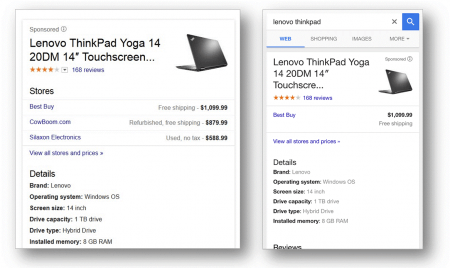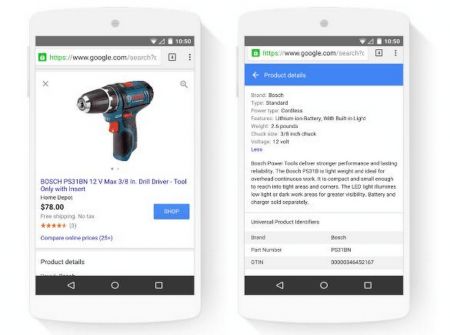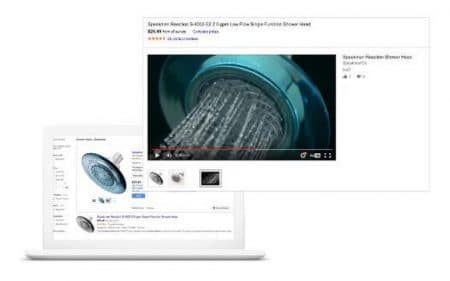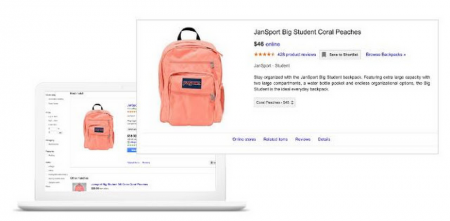Google Manufacturer Center is a free tool that allows brands to promote their products across Google platforms (e.g. Google.com, Google Shopping, Google Now and Google Express). By sharing detailed and authoritative product data with Manufacturer Center, brands attain greater visibility and improve shopping experiences for end consumers. Furthermore, brands can also increase the chances of selling for retail partners, as many of them also run ads on Google Ads and Merchant Center.
How Google Manufacturer Center works
When shoppers search using certain keywords and phrases, Google matches their query to the product information that you provided to Manufacturer Center and your retail partners. This effectively makes your products visible to shoppers. Thus, the higher the quality of product data you provide to Manufacturer Center, the greater the chances of your products being found and sold.
What shoppers see
Shoppers see text ads or the more visual “Placements Shopping Ads.” These contain a title, photo, price and other relevant information that shoppers need to have a better sense of your product and make a purchase.
In the Lenovo ThinkPad ad below, a shopper who searched for “Lenovo Thinkpad” would be shown this card to entice them to make a purchase. 
5 basic tips to optimize your content’s performance on Manufacturer Center
So how can you make the most out of Google Manufacturer Center? Follow these basic tips to improve how Google showcases your products:
- Leverage SEO – According to Google, in Manufacturer Center you have a better chance of ranking for highly competitive keywords than in Google search. Therefore, ensure your products are accurately listed on Google platforms and have keyword phrase-optimized titles and descriptions.
- Make detailed categories – Consumers today are information-driven. They tend to dig deeper. By being as granular as possible with categories, you’re helping them easily find what they’re looking for. Use Google’s Product Taxonomy as a guide.
- Showcase promotions – Who doesn’t want more bang for their buck? Use the “Merchant Promotions” option in Merchant Center to highlight a variety of promotions for your products, such as discounts or free shipping.
- Create high-quality product content – Product content should contain accurate, complete, up-to-date and rich product information. “Rich” content includes attention- grabbing titles, product descriptions that convert, essential instructions, key technical specifications, dynamic images, informative videos, basic FAQs, helpful consumer ratings, etc.
- Optimize content with analytics. Gain insight on your product’s ad performance – such as the number of clicks your product received versus the competition, or how often your product ads surface as a result of a search query in Google Shopping – to then improve your digital ad investment, content or even pricing.
Three brands that enjoyed increased conversions through Google Manufacturer Center
Manufacturer Center has three levels of attributes for your feed:
- Required
ID, description, GTIN, title, brand, image link
- Recommended
MPN, additional image link, product line, feature description
- Optional
Product name, product type, product detail, product page URL, disclosure date, release date, suggested retail price
Brands who found success in Manufacturer Center didn’t stop at “required” information, but also diligently provided “recommended” and “optional” information, as well as variant information (e.g. color, size, etc.).
- Bosch: +4%

What Bosch did: Added “compact and light” to the Bosch PS31BN Brushless Drill’s product description, and helped Google pull up this ad for users who searched for “lightweight drill.”
- Speakman: +8.1%

What Speakman did: Speakman used rich product data, such as multiple product images and videos showing their product in action, for Shopping ads. They targeted users searching for their Speakman Reaction and Icon showerheads.
- JanSport: +13%

What JanSport did: In the description for their Big Student model backpack, JanSport highlighted the product’s bestselling features – extra-large capacity, two large compartments and a water bottle pocket, helping shoppers realize what they need.
Google Manufacturer Center is a great tool to jump-start your e-commerce presence and increase your sales. Aside from the helpful tips above, how you consolidate, store, cleanse, enrich, update and eventually distribute your product data plays a significant role in your Manufacturer Center success. Investing in a robust PIM solution will help you address most of your product data management challenges and help you quickly distribute product data to retailers and the Manufacturer Center. The faster you get your product data in order and push it to the Manufacturer Center, the earlier it reaches consumers and the higher your chances of making a sale.
Learn more about PIM for manufacturers.




